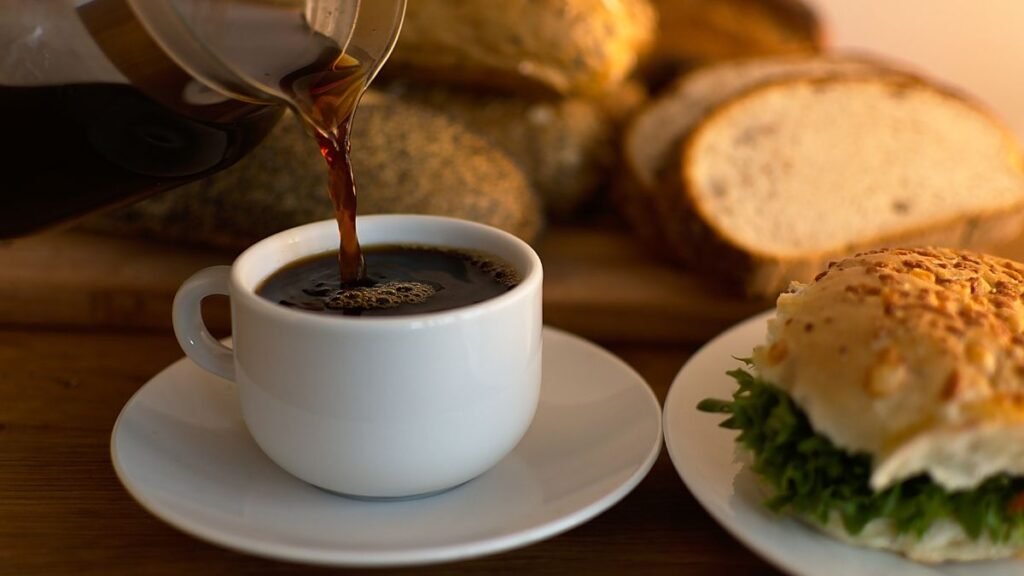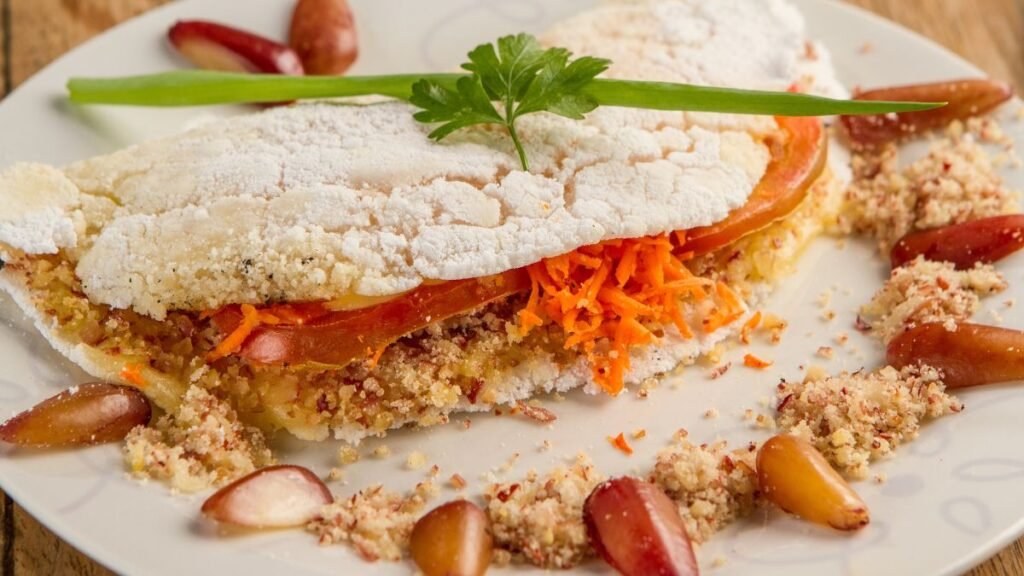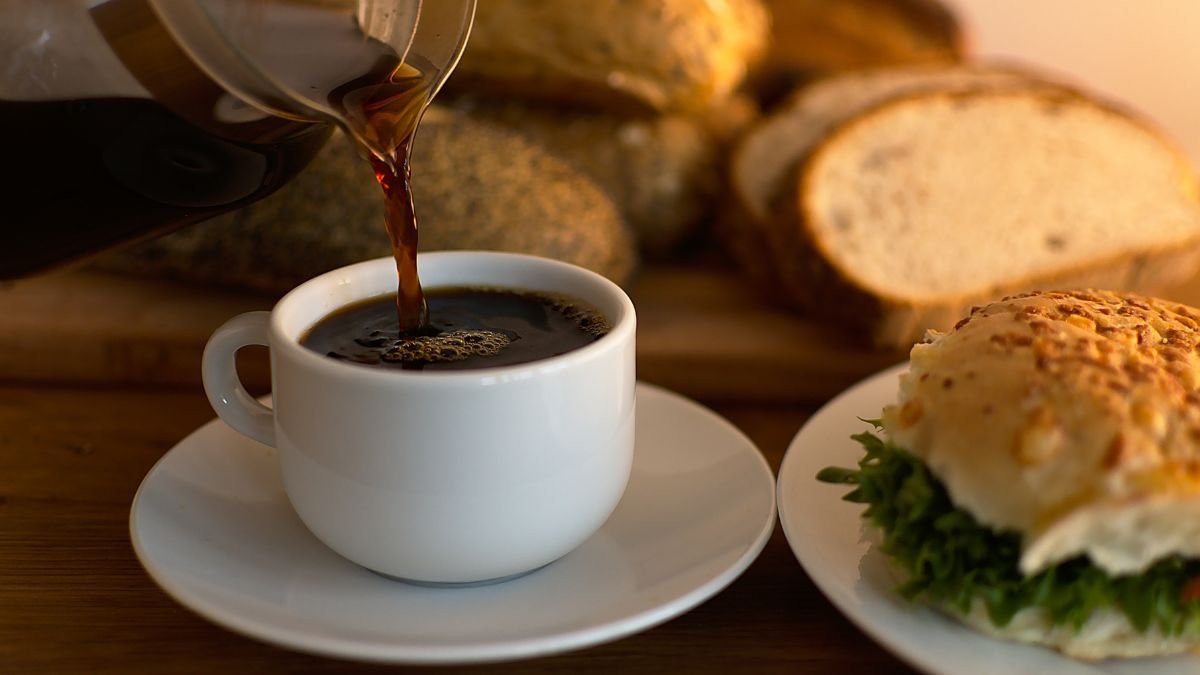Introduction
What if we told you that the key to a perfect start lies in the rich flavors and vibrant traditions of Brazilian breakfast? Known as Café da Manhã, this culinary experience is more than just a morning meal; it’s a reflection of Brazil’s diverse culture and cherished breakfast traditions.
Emphasizing lighter fare served between 6:30 and 8:00 a.m., the Brazilian breakfast showcases an array of ingredients, including coffee, fresh breads, decadent cakes, fruits, and savory cold cuts. While lunch often steals the spotlight as the main meal, the breakfast culture in Brazil deserves its moment of fame.
In this article, we’ll delve into the unique components that make up Brazilian cuisine’s morning ritual, alongside ways to recreate these delightful dishes at home.

Key Takeaways
- Brazilian breakfast, or Café da Manhã, emphasizes lighter fare and is typically enjoyed in the morning.
- Coffee is the cornerstone of Brazilian breakfast culture, often paired with a variety of breads and pastries.
- Although lunch is the main meal, breakfast holds a special place in Brazilian cuisine.
- This meal typically includes fruits, cakes, cold cuts, and an array of regional variations.
- Exploring these breakfast traditions offers insight into Brazil’s rich cultural fabric.
- Recreating traditional Brazilian breakfast items at home is a wonderful way to experience the culture.
Introduction to Brazilian Breakfast Culture
The Brazilian breakfast culture reflects the country’s rich and diverse food traditions. Known locally as Café da Manhã, breakfast holds significance in daily routines. Although lunch often takes the spotlight as the main meal, breakfast provides a flavorful start to the day. Typically characterized by freshness and simplicity, Brazilian breakfasts feature a variety of ingredients that showcase regional specialties.
Different areas contribute unique flavors and components to this morning meal, resulting in a colorful spectrum of choices. From tropical fruits to baked goods, the menu presents a delightful contrast of textures and tastes. This culinary variety not only offers nourishment but also serves as a means of connection to Brazilian culture, highlighting the importance of food traditions in everyday life.
Traditional Breakfast Elements in Brazil
The concept of a traditional Brazilian breakfast reflects the country’s regional diversity and the influence of diverse culinary practices. A typical morning meal in Brazil features an array of delicious offerings that combine both sweet and savory flavors. Bread typically takes center stage in this breakfast scene, with varieties like Pão Francês, sliced bread, and Pão de Sal. Common spreads, such as butter and margarine, pair perfectly with these breads, complemented by fillings like cheese and ham. Additionally, regional specialties, including Pão de Queijo and tapioca, showcase the rich culinary landscape of Brazil.
Common Ingredients
Breakfast in Brazil often incorporates fresh fruits, such as bananas and papayas, along with baked goods like cornmeal cake and vanilla cake. The abundance of fresh ingredients reflects the country’s tropical climate, providing healthful options for morning meals. You can learn more about the common ingredients in Brazil that make breakfast both delightful and nutritious.
Role of Coffee
Coffee holds a significant standing in Brazil’s breakfast culture. The beverage is usually served strong, either black or with milk, embodying the significance of coffee in Brazil. This ritual highlights not only the drink’s popularity but the country’s well-established café culture. Coffee is often enjoyed while engaging in conversations or social gatherings, enhancing relationships within families and friends.
For many Brazilians, savoring a morning cup of coffee maintains a daily tradition. This beloved drink elevates the breakfast experience, making it more than just a meal. It plays a pivotal role in creating opportunities for connection and conversation that enrich the fabric of Brazilian life.
Bolo de Fuba: A Sweet Start to Your Day
Bolo de Fuba, a cherished Brazilian cornmeal cake, stands out for its delightful balance of sweetness and nutty flavor. This traditional Brazilian cake is a staple on breakfast tables throughout Brazil, embodying the essence of comfort food. Its simple yet satisfying nature makes it an ideal choice to kickstart the day on a sweet note.
What is Bolo de Fuba?
Bolo de Fuba is a moist cake made primarily with cornmeal, sugar, eggs, and milk. Its texture is often described as fluffy yet dense, providing a comforting bite. The cake’s slight sweetness pairs perfectly with its distinctive corn flavor, making the Bolo de Fuba a unique addition to any breakfast spread. A staple in many Brazilian households, this cake is celebrated for its humble ingredients and heartwarming taste.
Variations and Serving Suggestions
Serving suggestions for Bolo de Fuba vary widely, showcasing its versatility. Many enjoy it plain or with a light dusting of powdered sugar. Notably, toppings enhance its appeal:
- Grated coconut adds a tropical flair.
- Fresh fruits, such as bananas or berries, complement its sweetness.
- Dulce de leche provides a rich, caramelized depth.
The cake is best enjoyed warm, paired with a robust cup of coffee or a refreshing glass of milk. Bolo de Fuba truly embodies the joy of Brazilian breakfast culture, making each morning a little brighter.
Tapioca Crepes: A Gluten-Free Delight
Tapioca Crepes have their roots deeply planted in Brazil’s indigenous culture, emerging as a beloved dish that highlights the versatility of cassava starch. These gluten-free breakfast offerings cater to a variety of tastes, serving as a canvas for both savory and sweet fillings. The cooking method is simple yet effective, transforming basic ingredients into a delightful crepe suitable for any time of day.
Origins of Tapioca Crepes
The origin of Tapioca Crepes can be traced back to Brazil’s rich culinary history. Made primarily from cassava, these crepes showcase the resourcefulness of the indigenous people who first utilized this starch. Over time, Tapioca Crepes have evolved into a staple in many Brazilian households, embodying local flavors and traditions.
Cooking Techniques and Popular Fillings
Creating the perfect Tapioca Crepes involves mixing tapioca flour with water, then pouring the mixture onto a hot pan. The result is a light and pliable crepe that can be easily filled. Popular choices for fillings include:
- Savory Fillings: Cheese, ham, eggs, and vegetables
- Sweet Fillings: Chocolate, coconut, and fruit jams
This flexibility in fillings makes Tapioca Crepes widely appealing, offering the perfect gluten-free breakfast option for everyone from children to adults. Each bite can transport you to the vibrant streets of Brazil, adding a splash of excitement to your morning routine.
Acai na Tigela: A Nutrient-Packed Bowl
Acai na Tigela offers a refreshing and nutritious breakfast experience, packed with essential nutrients. This Brazilian dish features a thick acai smoothie served in a bowl, often topped with an array of delicious ingredients. Among the many health benefits of acai, its high antioxidant content stands out, enhancing well-being while providing a burst of flavor. This makes Acai na Tigela a favored choice for breakfast enthusiasts.
The Health Benefits of Acai
The health benefits of acai berries are numerous. They are rich in antioxidants, which help combat oxidative stress and inflammation. Regular consumption of acai may contribute to heart health and improved cholesterol levels. Additionally, acai berries are packed with vitamins and minerals, supporting overall health and vitality.
Topping Options for Customization
The customization of Acai na Tigela is one of its most appealing aspects. You can personalize your bowl with various toppings, creating a meal that suits your taste and dietary needs. Popular options include:
- Bananas
- Coconut flakes
- Honey
- Nuts and seeds
- Granola
- Fresh berries
This flexibility allows you to enjoy a unique bowl each time while maximizing the health benefits of acai.
Pingado with French Bread: A Simple Pleasure
Pingado offers a delightful morning experience for those who enjoy a lighter coffee option. This beverage, a combination of steamed milk and rich espresso, pairs wonderfully with French bread for breakfast. The creamy texture of Pingado complements the warm, crusty loaf, creating a perfect harmony of flavors.
To enhance the enjoyment, many people spread butter on the French bread, allowing it to melt slightly into the warm crust. This simple addition elevates the dish, making every bite a comforting reminder of Brazilian breakfast traditions. The aroma of freshly brewed Brazilian coffee fills the air, stimulating the senses and preparing one for a productive day ahead.
Pão de queijo and French bread for breakfast not only maintain a cultural significance but also serve as a valuable ritual shared in many Brazilian households. It invites individuals to slow down, savor the moment, and connect over a shared culinary delight.
| Component | Description |
|---|---|
| Pingado | A blend of steamed milk and espresso, creating a smooth, rich coffee experience. |
| French Bread | A warm, crusty loaf that complements the texture of Pingado, often served with butter. |
| Variations | Served in different styles across Brazil, with local adaptations for flavor and texture. |
| Cultural Significance | Encourages family bonding and slow mornings, emphasizing the importance of breakfast in Brazilian culture. |
Pão de Queijo with Deli Meat: Cheesy Goodness
Pão de Queijo stands out as a beloved snack in Brazilian cuisine, celebrated for its unique flavor and texture. This traditional Brazilian cheese bread is made primarily with tapioca flour, making it a delightful gluten-free option. The chewy consistency and cheesy taste make it a favorite breakfast item throughout Brazil.
What is Pão de Queijo?
Pão de Queijo is a warm, cheesy bread that captures the essence of Brazilian comfort food. Often enjoyed fresh out of the oven, it has a rich and satisfying flavor profile that appeals to a wide audience. The combination of cheese and tapioca creates a soft interior with a slightly crispy exterior, making it irresistible.
Pairing Suggestions for Breakfast
For a truly enjoyable breakfast pairing, consider serving Pão de Queijo with deli meats like ham, turkey, or salami. These savory additions not only enhance the flavor of the cheese bread but also provide a fulfilling meal to kickstart the day. The contrast between the cheesy Pão de Queijo and the salty deli meats creates a wonderful balance, making every bite a delicious experience.
This combination pairs beautifully with a warm beverage such as coffee or tea, allowing you to savor a hearty breakfast while embracing the rich flavors of Brazilian cuisine. Experiment with different deli meats to find the perfect match for your taste preferences.
Feijão Tropeiro: A Hearty Breakfast Option
Feijão Tropeiro stands as a beloved choice within Brazilian breakfast staples, particularly in the heart of Minhas Gerais cuisine. This hearty dish showcases a delightful blend of flavors and textures, featuring beans, various types of sausage, and eggs. Often prepared with a touch of garlic and spices, it creates a filling meal that energizes diners for the day ahead.
The origins of Feijão Tropeiro can be traced back to the region of Minas Gerais, known for its diverse culinary traditions. The dish reflects the agricultural heritage of the area, where beans are a staple food. As a result, this meal encapsulates a piece of regional history, making it more than just a breakfast option. The combination of ingredients is not only satisfying but also tells the story of a culture rich in flavor and communal dining.
Feijão Tropeiro is typically served warm, often accompanied by rice or a side of fried plantains. Its versatility allows for numerous variations depending on personal preferences or regional influences. Some enjoy adding bacon or other cured meats for an even heartier experience. This dish serves as a perfect example of how Minhas Gerais cuisine emphasizes heartiness and simplicity while celebrating the variety of ingredients found in Brazil.
For anyone looking to explore Brazilian breakfast staples, Feijão Tropeiro offers a unique and fulfilling option. Not only does it satisfy hunger, but it also showcases the richness of Brazilian culture through its flavors and ingredients. This dish is a must-try for those eager to explore the culinary wonders of Brazil.
Exploring Other Brazilian Breakfast Items
Brazilian breakfast offers an array of delicious and culturally rich dishes that go beyond the more commonly known items. Exploring traditional Brazilian breakfast items reveals a world of flavors and textures, each representing unique regional specialties. Among these, Cuscuz com Ovo stands out, along with other favorites like Rabanada and Canjica.
Cuscuz com Ovo
Cuscuz com Ovo is a beloved dish made of steamed cornmeal, served alongside scrambled eggs. This dish showcases the heartiness of Brazilian breakfast, often accompanied by a variety of toppings or sides. The combination of cuscuz and eggs provides a fulfilling start to the day, offering both protein and carbohydrates, which are perfect for sustaining energy levels throughout the morning.
Rabanada and Canjica
Rabanada, akin to French toast, is another popular option, prepared by frying bread soaked in a mixture of egg and milk, then dusted with sugar and cinnamon. Variations of Rabanada may include toppings like fruit or sweetened condensed milk. Canjica, made from corn cooked with spiced milk, is often enjoyed during seasonal celebrations, such as Festa Junina. Both dishes highlight the diversity of traditional Brazilian breakfast items, blending flavors that reflect the country’s rich culinary heritage.

Regional Variations in Brazilian Breakfast
The diversity of Brazilian breakfasts mirrors the country’s vast and varied culture. Regional variations play a significant role in defining what a typical breakfast looks like in different parts of Brazil. Ingredients, cooking techniques, and cultural influences collectively showcase distinct Brazilian breakfast differences from north to south.
Northeast vs. Southeast
In the Northeast region, traditional breakfast staples such as corn couscous and beef jerky are commonly enjoyed. The culinary style here often emphasizes local ingredients and is characterized by bold, flavorful dishes. On the other hand, the Southeast region features a completely different breakfast experience. Items like Pão de Queijo, a cheese bread, and fresh fruit juices are popular, emphasizing a lighter and fresher approach. These regional variations highlight the unique cuisines found across Brazil.
Influences from Different Cultures
The richness of Brazilian breakfast is further enriched by various cultural influences. Indigenous, African, and Portuguese cuisines have all left their mark on breakfast items. The incorporation of these influences is evident in food choices, preparation methods, and meal presentation. Regional variations reflect not just local ingredients but also the historic blend of cultures, showcasing an array of flavors and textures that make Brazilian breakfast experience multifaceted.
Beverages to Accompany Your Breakfast
Brazilian breakfasts are not just about delicious food; they also feature an array of enticing breakfast beverages. Coffee reigns supreme among the options, embodying the rich coffee culture found throughout Brazil. As a traditional elixir, it complements the savory and sweet elements of breakfast perfectly.
Popular Breakfast Drinks
In addition to coffee, several other popular Brazilian breakfast drinks enrich the morning experience. Fresh fruit juices made from tropical fruits like orange, açaí, and guava offer refreshing flavors and essential nutrients. Smoothies, or “vitaminas,” often combine fruits with yogurt or milk for added creaminess. These drinks are not only nourishing but also enhance the overall vitality of a Brazilian breakfast.
Importance of Fresh Juices
Fresh juices play a crucial role among breakfast beverages. They not only add a burst of color to the table but also provide hydration and a natural source of vitamins. Selecting locally sourced fruits allows for a vibrant selection that enhances the taste and freshness. Brazilian breakfast drinks play a significant role in creating a balanced meal and fostering a connection to the country’s rich agricultural diversity.
Preparing a Brazilian Breakfast at Home
Cooking Brazilian cuisine at home provides an opportunity to savor its rich flavors and textures through simple yet delightful Brazilian breakfast recipes. Essential staples reflect Brazil’s vibrant culinary culture. From the sweet aroma of Bolo de Fuba to the cheesy indulgence of Pão de Queijo, these dishes promise an authentic experience.
Essential Recipes to Try
To embark on your journey of Brazilian breakfast preparation, consider these key recipes:
- Bolo de Fuba: This cornmeal cake is a beloved breakfast item, perfect for pairing with coffee.
- Pão de Queijo: These cheesy bread balls are gluten-free and incredibly addictive, making them a must-try.
- Tapioca Crepes: Versatile and gluten-free, tapioca can be filled with sweet or savory ingredients, catering to different palates.
For those eager to expand their culinary horizons, detailed recipes and additional ideas can be found in the informative resource on Brazilian breakfast recipes. Embracing these dishes will not only satisfy your taste buds but also allow you to engage with a cherished part of Brazilian culture.

| Recipe | Main Ingredients | Serving Style |
|---|---|---|
| Bolo de Fuba | Cornmeal, sugar, eggs, milk | Slice with coffee |
| Pão de Queijo | tapioca flour, cheese, eggs, milk | Warm, as a snack or breakfast |
| Tapioca Crepes | Tapioca flour, water, fillings (cheese, fruit) | Folded with fillings |
By trying these recipes, you’re not just preparing breakfast; you’re creating a connection to the heart of Brazilian culture. Each bite transports you to a lively morning in Brazil, making the effort worthwhile.
The Social Aspect of Brazilian Breakfast
Brazilian breakfast transcends mere sustenance; it embodies the warmth of familial ties and cultural heritage. The social aspects of breakfast in Brazil play a pivotal role in fostering bonds among family and friends. Gathering around the breakfast table encourages conversations, laughter, and shared experiences that enrich relationships and create lasting memories.
Breakfast as a Family Meal
In many Brazilian homes, breakfast serves as a significant opportunity for family meals. This is a time when everyone can come together to enjoy the diverse array of foods, from fresh fruits to traditional dishes. Sharing breakfast fosters communication and nurtures familial bonds, highlighting the importance of starting the day united.
Connecting with Brazilian Culture through Food
Breakfast in Brazil is more than just food; it is a celebration of local traditions and flavors that connect people with their cultural roots. Dishes like pão de queijo and açaí na tigela not only nourish the body but also evoke cherished memories of family gatherings. Embracing these social aspects of breakfast in Brazil allows individuals to honor their heritage while also enjoying the present moment.
| Social Aspects | Benefits |
|---|---|
| Strengthens family bonds | Improved relationships and communication |
| Celebrates cultural heritage | Preservation of culinary traditions |
| Encourages conversation | Facilitates sharing of ideas and experiences |
| Creates lasting memories | Fosters enjoyment and connection |
Brazilian Breakfast: A Culinary Adventure
Exploring Brazilian cuisine through breakfast offers a rich tapestry of flavors and traditions. Each meal unfolds like a story, revealing the deep-rooted cultural heritage that shapes Brazil’s diverse population. This culinary adventure takes you from the bustling streets of São Paulo to the serene beaches of Bahia, showcasing unique dishes that reflect the region’s distinct influences.
From Bolo de Fuba’s sweet simplicity to the savory delight of Pão de Queijo, breakfast items tell tales of local ingredients and historical practices. This exploration not only fuels the body but also nourishes the soul, inviting everyone to cherish the communal aspect of sharing meals. Engaging in such experiences offers profound insight into Brazilian lifestyle and values, transforming a simple breakfast into a memorable occasion.
A journey into Brazilian breakfast culture inspires appreciation for the country’s culinary evolution while encouraging adventurous palates to discover bold flavors and comforting traditions. Each dish serves as a gateway, making the act of eating a delightful exploration that goes beyond mere sustenance. Join in on this culinary adventure by embracing the snacks and beverages that are integral to Brazil’s vibrant morning routine.
Conclusion
The traditional Brazilian breakfast is a delightful reflection of the country’s diverse culture, brimming with flavors that range from the sweet indulgence of Bolo de Fuba to the savory satisfaction of Pão de Queijo. This summary of dishes highlights the significance of these breakfast items, which are not merely meals but experiences that connect people with their heritage and with one another.
Whether it’s the refreshing Acai na Tigela or the comforting Feijão Tropeiro, each dish contributes to a fuller understanding of Brazil’s rich culinary landscape. By embracing these traditions, individuals can enrich their morning routines while also expanding their culinary horizons, savoring a taste of Brazil in every bite.
Ultimately, starting the day with a traditional Brazilian breakfast not only nourishes the body but also nurtures the soul, making for a meaningful way to engage with a vibrant culture. Each dish invites exploration and appreciation, encouraging everyone to savor the joys of a truly remarkable breakfast experience. Learn more Brazilian cuisine.
FAQ
What time is breakfast typically served in Brazil?
Brazilian breakfast, known as Café da Manhã, is generally served between 6:30 and 8:00 am, focusing on lighter fare.
What are some common items included in a traditional Brazilian breakfast?
Breakfast in Brazil often includes staples like Pão Francês (French bread), butter, cheese, cold cuts, fresh fruits, cakes, Pão de Queijo (cheese bread), tapioca flatbreads, and fresh fruit juices.
Is coffee an essential part of Brazilian breakfast?
Yes, coffee serves as the centerpiece of Brazilian breakfast, typically prepared strong and sweet, symbolizing the country’s rich coffee culture.
What is Bolo de Fuba, and how is it typically served?
Bolo de Fuba is a traditional cornmeal cake renowned for its slightly sweet and nutty flavor, often served with toppings such as grated coconut, fresh fruits, or dulce de leche.
Can you explain the significance of tapioca crepes in Brazilian cuisine?
Tapioca crepes are made from cassava starch and serve as a gluten-free option in Brazilian breakfast. They can be enjoyed with a wide variety of sweet and savory fillings, reflecting the diverse culinary influences in Brazil.
What are the health benefits of Acai na Tigela?
Acai na Tigela is celebrated for its rich antioxidant content, making it a nutritious and satisfying breakfast option. It’s often topped with granola and fresh fruits for added flavor and health benefits.
What is Pingado, and how is it enjoyed with breakfast?
Pingado is a delightful beverage combining steamed milk with espresso, often served alongside warm French bread spread with butter, making for a comforting breakfast experience.
What makes Pão de Queijo a popular breakfast item?
Pão de Queijo is a traditional cheese bread made from tapioca flour, which gives it a unique, chewy texture. It’s often paired with deli meats like ham or turkey, enhancing its savory appeal.
Can you describe Feijão Tropeiro and its cultural significance?
Feijão Tropeiro is a hearty breakfast dish that combines beans, sausage, and eggs, providing a substantial meal that’s deeply rooted in Brazilian culinary traditions, particularly from the Minas Gerais region.
What are some notable regional differences in Brazilian breakfast?
Regional variations in Brazilian breakfast arise from local ingredients and cultural influences, with the Northeast featuring dishes like corn couscous and the Southeast showcasing items like Pão de Queijo and fresh juices.
What beverages are commonly served with Brazilian breakfast?
Popular breakfast drinks include strong coffee, fresh fruit juices made from tropical fruits, and smoothies, all of which enhance the overall meal experience.
How can I prepare a traditional Brazilian breakfast at home?
Preparing a Brazilian breakfast at home is achievable with simple recipes for key items, such as Bolo de Fuba, Pão de Queijo, and Tapioca Crepes, allowing you to experience the flavors of Brazil in your own kitchen.
What role does breakfast play in Brazilian culture?
Breakfast often serves as a social meal where family and friends gather to enjoy food together, reflecting cultural traditions and fostering community ties through shared culinary experiences.




